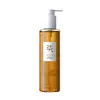What's inside
What's inside
 Key Ingredients
Key Ingredients

 Benefits
Benefits

 Concerns
Concerns

 Ingredients Side-by-side
Ingredients Side-by-side

Glycine Soja Oil
EmollientEthylhexyl Palmitate
EmollientIsopropyl Palmitate
EmollientSorbeth-30 Tetraoleate
EmulsifyingHelianthus Annuus Seed Oil
EmollientIsononyl Isononanoate
EmollientIsopropyl Myristate
EmollientPrunus Amygdalus Dulcis Oil
Skin ConditioningTriethylhexanoin
MaskingEthylhexyl Stearate
EmollientPolyisobutene
Caprylic/Capric Triglyceride
MaskingCitrus Aurantium Dulcis Peel Oil
Masking1,2-Hexanediol
Skin ConditioningPelargonium Graveolens Flower Oil
MaskingPentaerythrityl Tetra-Di-T-Butyl Hydroxyhydrocinnamate
AntioxidantSalvia Officinalis Oil
MaskingPogostemon Cablin Leaf Oil
MaskingCrambe Abyssinica Seed Oil
Skin ConditioningCitrus Aurantium Bergamia Fruit Oil
MaskingAnthemis Nobilis Flower Oil
MaskingCaprylyl Glycol
EmollientEthylhexylglycerin
Skin ConditioningMelaleuca Alternifolia Leaf Oil
AntioxidantWater
Skin ConditioningBiosaccharide Gum-4
Skin ConditioningTocopherol
AntioxidantLimonene
PerfumingCitronellol
PerfumingGeraniol
PerfumingLinalool
PerfumingGlycine Soja Oil, Ethylhexyl Palmitate, Isopropyl Palmitate, Sorbeth-30 Tetraoleate, Helianthus Annuus Seed Oil, Isononyl Isononanoate, Isopropyl Myristate, Prunus Amygdalus Dulcis Oil, Triethylhexanoin, Ethylhexyl Stearate, Polyisobutene, Caprylic/Capric Triglyceride, Citrus Aurantium Dulcis Peel Oil, 1,2-Hexanediol, Pelargonium Graveolens Flower Oil, Pentaerythrityl Tetra-Di-T-Butyl Hydroxyhydrocinnamate, Salvia Officinalis Oil, Pogostemon Cablin Leaf Oil, Crambe Abyssinica Seed Oil, Citrus Aurantium Bergamia Fruit Oil, Anthemis Nobilis Flower Oil, Caprylyl Glycol, Ethylhexylglycerin, Melaleuca Alternifolia Leaf Oil, Water, Biosaccharide Gum-4, Tocopherol, Limonene, Citronellol, Geraniol, Linalool
Glycine Soja Oil
EmollientCetyl Ethylhexanoate
EmollientSorbeth-30 Tetraoleate
EmulsifyingIsododecane
EmollientOlea Europaea Fruit Oil
MaskingCamellia Japonica Seed Oil
EmollientHydrogenated Coconut Oil
EmollientOctyldodecanol
EmollientPolybutene
Caprylic/Capric Triglyceride
MaskingWater
Skin ConditioningTocopherol
AntioxidantSalvia Officinalis Oil
MaskingPanax Ginseng Seed Oil
EmollientArtemisia Vulgaris Oil
PerfumingOcimum Basilicum Oil
MaskingCorylus Avellana Seed Oil
EmollientNigella Sativa Seed Oil
EmollientButylene Glycol
HumectantPanax Ginseng Berry Extract
Skin ConditioningGlycerin
Humectant1,2-Hexanediol
Skin ConditioningMethylpropanediol
SolventPanax Ginseng Root Extract
EmollientEthyl Hexanediol
SolventPanax Ginseng Extract
AntioxidantPanax Ginseng Leaf/Stem Extract
Skin ConditioningEthylhexylglycerin
Skin ConditioningGlycine Soja Oil, Cetyl Ethylhexanoate, Sorbeth-30 Tetraoleate, Isododecane, Olea Europaea Fruit Oil, Camellia Japonica Seed Oil, Hydrogenated Coconut Oil, Octyldodecanol, Polybutene, Caprylic/Capric Triglyceride, Water, Tocopherol, Salvia Officinalis Oil, Panax Ginseng Seed Oil, Artemisia Vulgaris Oil, Ocimum Basilicum Oil, Corylus Avellana Seed Oil, Nigella Sativa Seed Oil, Butylene Glycol, Panax Ginseng Berry Extract, Glycerin, 1,2-Hexanediol, Methylpropanediol, Panax Ginseng Root Extract, Ethyl Hexanediol, Panax Ginseng Extract, Panax Ginseng Leaf/Stem Extract, Ethylhexylglycerin
 Reviews
Reviews

Ingredients Explained
These ingredients are found in both products.
Ingredients higher up in an ingredient list are typically present in a larger amount.
1,2-Hexanediol is a synthetic liquid and another multi-functional powerhouse.
It is a:
- Humectant, drawing moisture into the skin
- Emollient, helping to soften skin
- Solvent, dispersing and stabilizing formulas
- Preservative booster, enhancing the antimicrobial activity of other preservatives
This ingredient is an emollient, solvent, and texture enhancer. It is considered a skin-softener by helping the skin prevent moisture loss.
It helps thicken a product's formula and makes it easier to spread by dissolving clumping compounds.
Caprylic Triglyceride is made by combining glycerin with coconut oil, forming a clear liquid.
While there is an assumption Caprylic Triglyceride can clog pores due to it being derived from coconut oil, there is no research supporting this.
Learn more about Caprylic/Capric TriglycerideEthylhexylglycerin (we can't pronounce this either) is commonly used as a preservative and skin softener. It is derived from glyceryl.
You might see Ethylhexylglycerin often paired with other preservatives such as phenoxyethanol. Ethylhexylglycerin has been found to increase the effectiveness of these other preservatives.
Glycine Soja Oil comes from the soybean. Glycine Soja is native to eastern Asia.
Soybean oil is an emollient. It is rich in antioxidants and fatty acids including palmitic, stearic, oleic, and linoleic acids.
As an emollient, the fatty acids in soybean oil helps keep your skin soft and hydrated. It does so by creating a film on top that traps moisture in.
Soybean oil is also rich in vitamin E, a potent antioxidant. Vitamin E is also anti-inflammatory and provides a soothing effect.
Studies show soy may help fade hyperpigmentation from UVB. It does so by disrupting the melanin process from UVB induced skin inflammation.
This ingredient may not be malassezia folliculitis, or fungal-acne, safe.
Soybeans are rich in proteins and are part of the legume family. Foods made with soybeans include tofu, soymilk, edamame, miso, and soy sauce.
Learn more about Glycine Soja OilSalvia Officinalis Oil is an oil.
Sorbeth-30 Tetraoleate is a surfactant and emulsifier.
This ingredient is a tetraester from oleic acid and polyethylene glycol ether of sorbitol.
As an emulsifier, it helps ingredients such as oil and water mix together. This allows the dirt and oils in your skin to be washed away.
One study found pumpkin oil containing Sorbeth-30 Tetraoleate helped hydrate the skin and did not cause any irritation.
Learn more about Sorbeth-30 TetraoleateTocopherol (also known as Vitamin E) is a common antioxidant used to help protect the skin from free-radicals and strengthen the skin barrier. It's also fat soluble - this means our skin is great at absorbing it.
Vitamin E also helps keep your natural skin lipids healthy. Your lipid skin barrier naturally consists of lipids, ceramides, and fatty acids. Vitamin E offers extra protection for your skin’s lipid barrier, keeping your skin healthy and nourished.
Another benefit is a bit of UV protection. Vitamin E helps reduce the damage caused by UVB rays. (It should not replace your sunscreen). Combining it with Vitamin C can decrease sunburned cells and hyperpigmentation after UV exposure.
You might have noticed Vitamin E + C often paired together. This is because it is great at stabilizing Vitamin C. Using the two together helps increase the effectiveness of both ingredients.
There are often claims that Vitamin E can reduce/prevent scarring, but these claims haven't been confirmed by scientific research.
Learn more about TocopherolWater. It's the most common cosmetic ingredient of all. You'll usually see it at the top of ingredient lists, meaning that it makes up the largest part of the product.
So why is it so popular? Water most often acts as a solvent - this means that it helps dissolve other ingredients into the formulation.
You'll also recognize water as that liquid we all need to stay alive. If you see this, drink a glass of water. Stay hydrated!
Learn more about Water